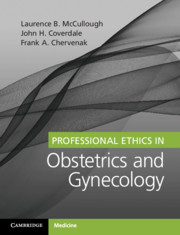Book contents
- Professional Ethics in Obstetrics and Gynecology
- Professional Ethics in Obstetrics and Gynecology
- Copyright page
- Dedication
- Contents
- Preface
- Acknowledgments
- Section 1 Professional Ethics in Obstetrics and Gynecology
- Chapter 1 Professional Ethics in Medicine
- Chapter 2 Professional Ethics in Obstetrics and Gynecology
- Chapter 3 Decision Making By, With, and For Patients
- Chapter 4 Confidentiality
- Chapter 5 Conflicts of Interest and Conflicts of Commitment
- Section 2 Pedagogy of Professional Ethics in Obstetrics and Gynecology
- Section 3 Professionally Responsible Clinical Practice
- Section 4 Professionally Responsible Leadership
- Section 5 Professionally Responsible Innovation and Research
- Section 6 Professionally Responsible Health Policy and Advocacy
- Glossary of Key Concepts
- Index
- References
Chapter 2 - Professional Ethics in Obstetrics and Gynecology
from Section 1 - Professional Ethics in Obstetrics and Gynecology
Published online by Cambridge University Press: 01 November 2019
- Professional Ethics in Obstetrics and Gynecology
- Professional Ethics in Obstetrics and Gynecology
- Copyright page
- Dedication
- Contents
- Preface
- Acknowledgments
- Section 1 Professional Ethics in Obstetrics and Gynecology
- Chapter 1 Professional Ethics in Medicine
- Chapter 2 Professional Ethics in Obstetrics and Gynecology
- Chapter 3 Decision Making By, With, and For Patients
- Chapter 4 Confidentiality
- Chapter 5 Conflicts of Interest and Conflicts of Commitment
- Section 2 Pedagogy of Professional Ethics in Obstetrics and Gynecology
- Section 3 Professionally Responsible Clinical Practice
- Section 4 Professionally Responsible Leadership
- Section 5 Professionally Responsible Innovation and Research
- Section 6 Professionally Responsible Health Policy and Advocacy
- Glossary of Key Concepts
- Index
- References
Summary
This chapter provides an introduction to professional ethics in obstetrics and gynecology based on the ethical concept of medicine as a profession and the ethical concepts of the female patient, pregnant patient, and fetal patient. There is also an introduction to professional ethics in perinatal medicine.
- Type
- Chapter
- Information
- Professional Ethics in Obstetrics and Gynecology , pp. 24 - 44Publisher: Cambridge University PressPrint publication year: 2019

